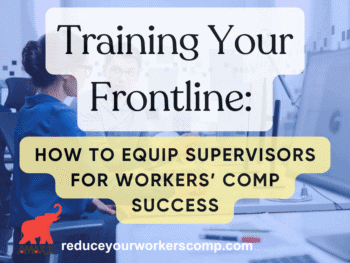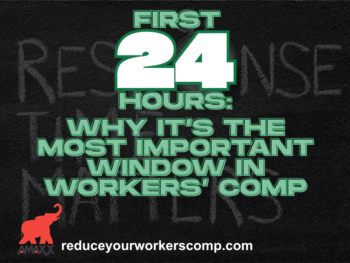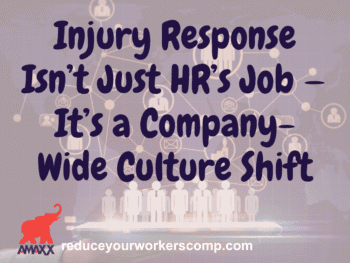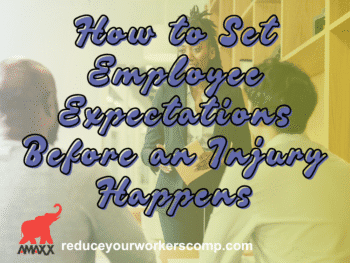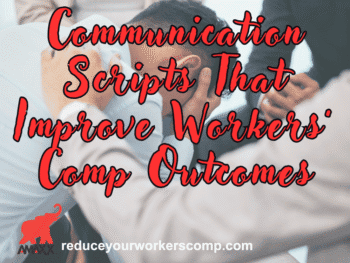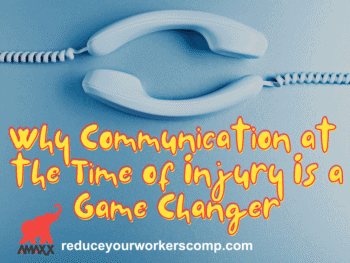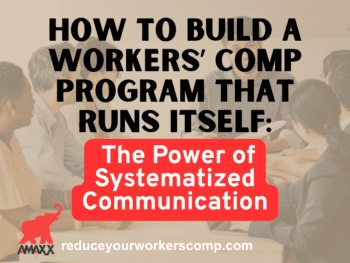
Communication is an effective manner to reduce workers’ compensation costs. This is because it drives empathy, promotes engagement, and allows the employer and claim management team to open lines of communication.
Interested stakeholders seeking to reduce program costs should take some simple steps to promotes better communication with the employee following a work injury.
This post is one in a 3-part series:
Explain the Workers’ Compensation Process
Claim handlers and employer representatives are at an advantage when it comes to the workers’ compensation process. This is because they “know” the process, and how it works. This is based on prior experience they have with countless claims. On the other hand, most employees have their first experience with the workers’ compensation process following an injury. There is nothing wrong with leveling the playing field and providing information to the employee.
Click Link to Access Free PDF Download
“9-Element Blueprint To Create Your Workers’ Comp Employee Brochure”
- Providing easy to follow flowcharts on the claim process. This can include what happens if a claim is denied, and how to appeal the insurance carrier’s decision.
- Workers’ compensation benefit information. This can include entitlement information on indemnity, medical, and vocational rehabilitation benefits; and
- Contact information with the claim management team, employer, and state agency responsible for overseeing the workers’ compensation process.
It can also be helpful to provide the employee with tools to organize their workers’ compensation information. This can include a notepad, folder, and pen so they can keep everything accessible.
Provide Policies and Procedures
Employees receive a lot of information following a work injury. Most of the information is being set because there is a reason for it being mailed out. Do not limit what is sent to only those required by law. Additional information that is useful can assist the employee in understanding the claims process, and get them back to work.
Providing the injured employee with information on return-to-work is something every interested stakeholder should consider.
- Return-to-work provides financial benefits to employers. It allows them to remain productive and eliminates the need to make schedule changes, and move others around.
- Return-to-work provides social connections, and allows the employee to retain financial security, and skill retention following a work injury. Employees that return to work quicker have better outcomes.
- Return-to-work also boasts workplace morale. Everyone wins!
Effective return-to-work policies must be provided to all employees following a work injury. Every policy will explain the process, and outline goals and expectations of all parties. It will let the employee know that if work is available and within their restrictions, they can be expected to work. It will also outline how the job offer will be communicated, who will be making the job offer, the options available after the offer is made, when the offer must be accepted, and ramifications for not accepting it.
The goals of the policy will also be outlined. There must be an emphasis on workplace safety, and why full participation and effort is needed. The benefits of the policy should also be outlined. It is important to remember that labor union collective bargaining agreements need to be consider to avoid conflict with state and national labor laws. If a collective bargaining agreement is in place, union leaders should be engaged to get input, and buy-in to the process.
Consistent Follow-up Required
It is also important for employer and insurance interests to check-in on a regular basis with an employee following a work injury. This includes ensuring their emotional needs are being taken care of after an incident. Suggestions for effective follow-up include:
- Sending a “get well soon” card following a work injury. Take the time to personalize it and include a message of good will;
- Calling the employee on a weekly basis with the sole purpose of checking on the status of their recovery. Ask about improvement in their condition, and discuss issues that are not related to workers’ compensation matters. Demonstrating true empathy is key; and
- Encourage the employee to stop by the employer’s physical location over a break period to socialize with friends who are co-workers. Give the employee physical space within preset parameters.
Conclusions
Communication is a key way to reduce workers’ compensation program costs. This can include easy to implement ideas that seek to increase workplace morale, and are based in empathy. Every step taken should include return-to-work measures. The goal is to get the employee back to work in a safe, and timely manner.
 Author Michael Stack, CEO Amaxx LLC. He is an expert in workers’ compensation cost containment systems and helps employers reduce their workers’ comp costs by 20% to 50%. He works as a consultant to large and mid-market clients, is a co-author of Your Ultimate Guide To Mastering Workers Comp Costs, a comprehensive step-by-step manual of cost containment strategies based on hands-on field experience, and is the founder & lead trainer of Amaxx Workers’ Comp Training Center, which offers the Certified Master of Workers’ Compensation national designation.
Author Michael Stack, CEO Amaxx LLC. He is an expert in workers’ compensation cost containment systems and helps employers reduce their workers’ comp costs by 20% to 50%. He works as a consultant to large and mid-market clients, is a co-author of Your Ultimate Guide To Mastering Workers Comp Costs, a comprehensive step-by-step manual of cost containment strategies based on hands-on field experience, and is the founder & lead trainer of Amaxx Workers’ Comp Training Center, which offers the Certified Master of Workers’ Compensation national designation.
Contact: mstack@reduceyourworkerscomp.com.
Workers’ Comp Roundup Blog: https://blog.reduceyourworkerscomp.com/
©2021 Amaxx LLC. All rights reserved under International Copyright Law.
Do not use this information without independent verification. All state laws vary. You should consult with your insurance broker, attorney, or qualified professional.





